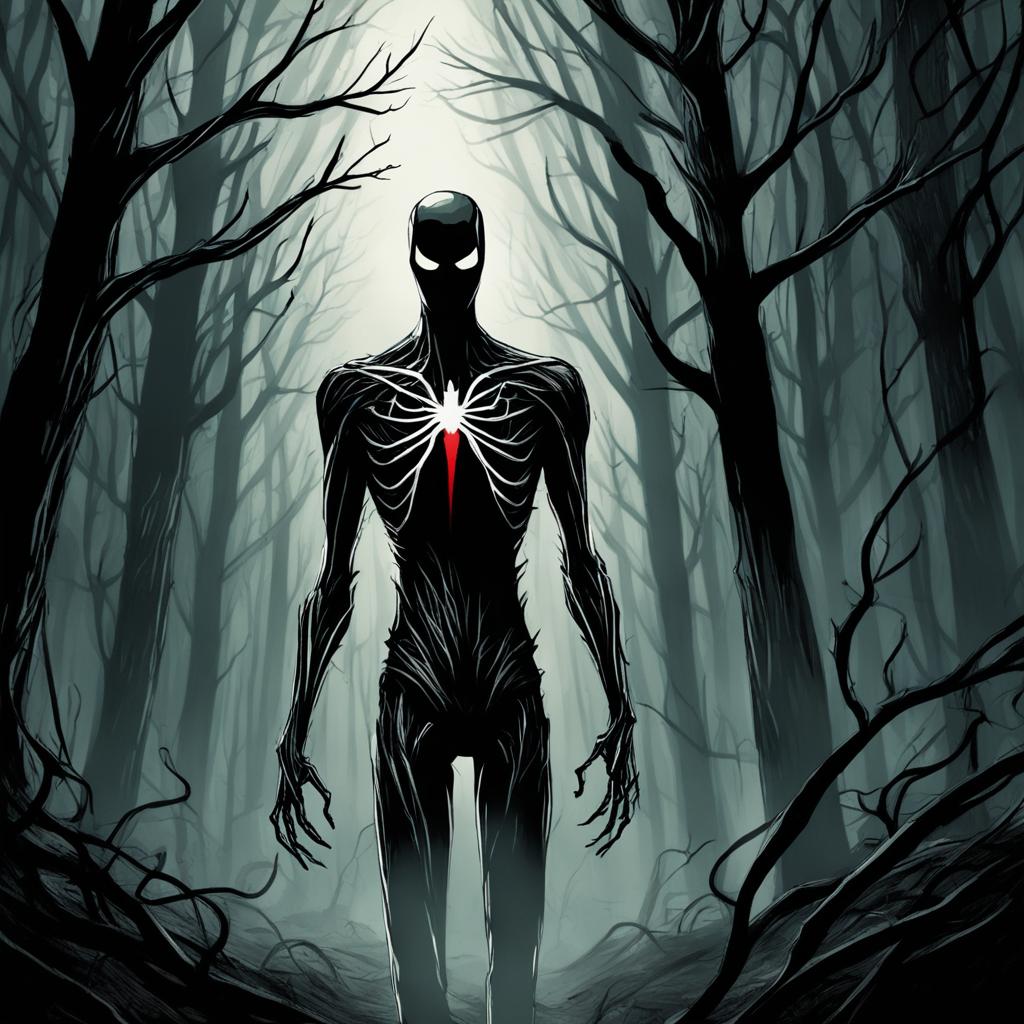On June 8, 2009, Eric Knudsen, also known as “Victor Surge,” introduced the world to the Slender Man on the “Something Awful” website. This was through photoshopped images. Little did he know, it would transcend internet lore to reality. This ghastly figure quickly made its presence known, in videos, games, and even television. Beyond the eerie visuals, real-life incidents such as the “Waukesha Stabbing” and suicide waves indicate a chilling power.
As the myth spread, so did the intensity of stories and sightings of the Slender Man. This tall, featureless entity captured minds with its unnatural appearance and ominous tales. It created an entire subculture online. The reach of this sinister entity is far and wide, from captivating millions on “Marble Hornets” to cameo appearances in popular culture, like ‘Minecraft’ and ‘Law & Order: SVU’. The Slender Man is, without a doubt, a modern-day, ubiquitous urban legend.
Origins of the Slender Man Mythos
The story of the Slender Man has entranced the online world since its beginnings on the Something Awful forum in 2009. This mysterious being, distinguished by his tall, slim figure, blank face, and unnaturally long limbs, is now a central part of horror fiction.
Eric Knudsen’s Inception of the Slender Man Character
Eric Knudsen, using the pseudonym “Victor Surge,” birthed the Slender Man in a unique manner. In reply to a forum initiative seeking altered photos for new story material, Knudsen shared eerie pictures. These depicted youths and children, innocently captured, with the foreboding presence of the Slender Man lurking. The images were blurred by cryptic, unsettling captions, mimicking supposed viewer testimonies.
Evolution from Something Awful Forum to Creepypasta Phenomenon
This single introduction spawned a whirlwind of creativity on the Something Awful platform. Others swiftly wove the Slender Man into their narrative fabric, or shared stories of harrowing, chance encounters. This flurry of activity birthed a complex mythos, which soon outgrew the forum’s bounds.
The legend leapt from the screen, proliferating across the web through creepypasta, where scary stories find digital life. Buzzing through forums and social media, the Slender Man stories gripped a wider audience. He stood not just as a character, but as a haunting legend, with tales of those who’d allegedly met him shrouded in mystery, fear, and forewarning.


“You’ll know him when you see him. That is, if he allows you to see him.”
The Unsettling Appearance of Slender Man
The Slender Man legend has grasped people’s attention for more than ten years. It’s the eerie look of this figure that draws us in. Despite slight changes by different writers, his typical attributes remain intact.
Abnormally Tall and Slender Humanoid Figure
Slender Man stands out due to his uncommon height and slim silhouette. He’s shown wearing a dark attire, which only adds to his unsettling aura. This depiction makes him both imposing and eerie, creating a feeling of fear in those who see him.
Featureless Pale Face and Disturbingly Long Limbs
His most striking feature is his face, plain and pallid, lacking any facial features. This blank countenance enhances his alien and eerie quality. Slender Man’s tales are filled with descriptions of his arms stretching beyond the expected, adding to his creep factor.


“Slender Man’s creation dates back to a thread on Something Awful in 2009, sparking the development of fan art, web series, video games, and internet mythology.”
Over time, the Slender Man legend has grown, with various interpretations showcasing his fear-inducing nature. His size, his face without features, his elongated limbs; these elements contribute to his terrifying narrative. This figure continues to frighten and intrigue people everywhere.
Slender Man’s Chilling Narrative Tropes
The Slender Man mythos has gripped audiences with its eerie narrative elements. These elements address basic human fears. There isn’t a single, agreed-upon story about the Slender Man, yet common themes and symbols appear in many of these stories.
Luring Children into Foreboding Forests and Liminal Spaces
Slender Man’s stories are especially dread-inducing as they describe how he draws children from their safe havens. These tales often feature dark forests or other strange, isolated settings. The backdrop of his unsettling figure in these places deepens the fear readers experience. Slender: The Eight Pages video game quickly gained over 2 million downloads. It drew players into its eerie digital forest and the pervasive threat of the Slender Man.
The focus on the Slender Man’s interest in children amplifies the horror. He is shown as a menace targeting the innocent. Early tales warned of a “Slender sickness,” tainting those who crossed his path, underscoring his evil presence.
“He appears in the trees, watching, waiting. He lures the children away, never to be seen again.”
This signature narrative, where the Slender Man draws children off into the shadows, epitomizes the fear of the unknown. It highlights the deep anxiety around children’s safety.


The Viral Spread of Slender Man Stories
The internet folklore around Slender Man has captured people’s attention globally, spreading rapidly after Eric Knudsen’s 2009 debut on the Something Awful forum. This digital myth quickly evolved, with numerous users contributing fresh narratives and insights. Thus, a myriad of stories emerged, making it hard to pinpoint a single, definitive portrayal of Slender Man.
Its impact wasn’t limited to the online forum. It influenced different media forms, including a well-received YouTube series that chronicled alleged encounters with the mysterious being. Marble Hornets, a series growing out of the Slender Man myth, reached major success with over 100 million views across episodes and additional content.
In 2012, the game Slender: The Eight Pages became an instant hit, seeing over 2 million downloads in its first month. The game offered players a terrifying glimpse into the Slender Man’s world. This success echoed in the movie industry with the 2015 film adaptation of the web series, Always Watching: A Marble Hornets Story.
The spread and lasting fame of the Slender Man myth exemplify how online tales can captivate and become prominent in mainstream culture. As it continues to influence various forms of media and inspire new creations, it stands as a living testament to the power of internet lore in the modern era.


“The Slender Man character has only been in existence for less than a decade but has managed to infiltrate global consciousness unprecedentedly.”
Urban Legends: Slender Man’s Crossover into Mainstream Media
The inception of the Slender Man sparks debate, yet unanimous is its meteoric ascension into the lexicon of modern urban legends. Originating from a forum post on Something Awful in 2009, the entity has morphed into an iconic figure. Its eerie visage and sinister tales have mesmerized a global audience, transcending the confines of its birth on online forums.
The cadence of his emergence – a svelte, faceless specter donned in a dark suit, replete with abnormally elongated appendages – renders him a globally identifiable symbol. This enigmatic figure has effortlessly implanted himself in the fabric of mainstream media, infiltrating films, television series, video games, and content spawned by enthusiasts. Propelling his characterization as a modern urban legend, the Slender Man pervades various facets of contemporary culture.
“The Slender Man is a tall, faceless man in a black suit who lurks in the shadows, preying on the innocent and the unsuspecting. His very presence is enough to strike fear into the hearts of those who encounter him.”
His induction into the realms of mainstream media has exponentially enriched his notoriety. The narrative surrounding his existence and his dubious capabilities, from teleportation to mind manipulation, alongside his knack for coercing individuals into “Proxies,” has captivated the masses. This lore, coupled with his foreboding presence, fuels interest in his mythos.


Nonetheless, the Slender Man’s migration into mainstream society has its grim adversities. A seminal episode occurred in 2014, famously known as the “Slender Man Stabbing,” where two adolescents sought to slay a peer, influenced by the Slender Man’s mythology. This incident ignited a far-reaching social upheaval concerning the peril of urban legends and creepypastas grounded in digital folklore.
Notwithstanding these vexing episodes, the Slender Man’s cultural imprint remains indelible. His allure across media platforms stands as a testament to the enduring potency of narrative in the digital epoch. The enigma surrounding this urban legend underscored the human fascination with the eerie and inscrutable, immortalizing him within the annals of popular culture.
Real-Life Tragedies and the Slender Man Moral Panic
The Infamous Slender Man Stabbing Case
In 2014, the fatal power of internet tales hit a peak when Anissa Weier and Morgan Geyser tried to kill a classmate. Their target was a sixth-grader named Payton Leutner. These two 12-year-olds were deeply dedicated to the monstrous fiction figure known as Slender Man.
This planned attack sparked a crisis about the dangerous influence of Slender Man tales on youths. Despite Geyser’s schizophrenia diagnosis, it showed how online myths could encourage harmful acts. This was a harsh lesson about the strength of digital folklore on fragile minds.
“The internet culture is now at the center of blame for the criminal act committed by the girls.”
Soon, parents and advocacy groups demanded the end of websites spreading Slender Man-like stories. They feared such tales could lead to more violence. This event also reopened the argument about a link between entertainment, including movies and games, and criminal actions.


The Slender Man Stabbing case acts as a poignant warning about online and offline reality blend. The rise of digital folklore underscores the importance of being media-savvy and skeptical. It challenges us to discern fact from fiction more than ever. This task calls for careful observation and deep insight both at an individual and societal level.
The Enduring Legacy of Slender Man
The Slender Man character, despite controversies and tragic events, holds a lasting influence in modern culture. His eerie appearance, coupled with a compelling narrative and widespread dissemination, has cemented his place as an internet folklore and creepypasta icon.
The inception of Slender Man can be traced back to 2009 on the Something Awful forum, marking its start as an internet meme. Transitioning into a prominent creepypasta, the entity’s visually distressing depiction resonated deeply with the public, tapping into universal fears and insecurities.
Slender Man’s effects on the cultural landscape are profound, extending to video games, literature, and a Hollywood film. This influence is evident in various documentaries as well, which reflect on its origins, the dark incidents linked to its lore, and broader implications of digital folklore.
Academics specializing in folklore, psychology, and internet phenomena have dissected Slender Man’s enduring appeal. They explore how the narrative themes, particularly regarding the lure of children to ominous locations, have captivated audiences. This discussion highlights the efficacy of collective storytelling, especially in a digital context.
The ongoing presence of Slender Man across multiple media and the consistent examination of his mythos underlines his continuing relevance. These aspects portray the profound impact of this urban legend on public imagination, showcasing the power of internet-driven storytelling and the attraction to the darker aspects of fiction.
Exploring the Psychological Impact of Creepypasta
The tales of creepypasta, like the Slender Man legend, have drawn in people from all over. Why do these stories grip us so tightly? They tap into our love for the unknown and our excitement for controlled fear.
Today, over 15,000 stories call the Creepypasta Wiki home. They range widely in quality, from “awesome” to “mediocre” to “retarded,” as the community rates them. This corner of the internet includes creepy JPEG stories and eerie single images, like the “shitbrix” photos that stir up unease.
Scientists say tales like Slender Man stick with us because they hit on our deepest fears. A psychologist mentioned that these stories connect deeply to our survival and urge for social connection. Slender Man’s story, for example, plays on our fear for children in the woods, bringing out strong negative emotions.
“The internet may influence how folk tales are crafted, potentially making stories more ghoulish and less focused on social content.”
Once, scary stories taught us important social lessons. But the internet is creating a new kind of creepy story. This new breed thrives on the purely scary and the unknown. It shows how big the draw of horror and pushing our fear’s limits is.
The fame of the Slender Man and creepypasta showcases our lasting interest in dark tales. As tech changes how we tell stories, the psychological effect of these chilling narratives changes too. They keep grabbing our attention, promising to do so for years to come.
The Future of Internet Folklore
The internet is changing our world, and internet folklore is changing with it. The story of the Slender Man shows how quickly and strongly online communities can form. They unite around fake but spooky tales, using the digital world to spread them far and wide.
This digital world makes it easy to create hoaxes with photo and video editing. A striking example is the Momo Challenge, which caused panic online. Even though it was proven fake, it spread like wildfire on platforms such as WhatsApp and YouTube.
The boundary between what’s true and what’s not on the internet is getting thinner. It’s important to learn why people are drawn to creepy online stories. The case of the Slender Man affecting two girls to try and kill their friend highlights the real, and sometimes dangerous, impact these tales can have.
“The power of online storytelling and folklore is evidenced by the fact that individuals have taken drastic actions in the name of tales like that of Slenderman, showcasing how narratives can influence behavior.”
What will internet folklore be like in the future? Some believe these new myths won’t last as long as the old ones. But, fast technology changes and new ways of connecting online suggest the future of these tales will be both interesting and hard to guess.
As the digital world becomes more entwined with our lives, the stories we tell online matter. The Slender Man story warns us. It reminds us to think critically and be careful when diving into online stories, which can be alluring but also unsettling.
Separating Fiction from Reality
The tale of the Slender Man is a stark illustration of the need for media literacy and sharp thinking. It’s clear the Slender Man is a fictional being. But, the link to real-life tragedies highlights the danger of mixing up what’s real and what’s not.
It’s vital that we are able to tell fact from fiction today. With the internet, stories like the Slender Man can travel fast and have an impact. By improving media literacy, especially in the younger generation, we can grasp the implications of these tales on our beliefs and actions.
The Importance of Media Literacy and Critical Thinking
Reflecting on the Slender Man, it’s evident we need to think critically about what we see online. The character’s rise to fame through creepypasta stories made it hard to distinguish fact from fantasy. This led to real-life tragedies. Media literacy and the insight to tell fiction from the truth are key to handling stories in the digital age without real-world harm.
“The more we can encourage critical thinking and media literacy, the better equipped people will be to discern fact from fiction and avoid the potential dangers of blending the two.”
Understanding why these stories spread helps us navigate the world of internet-based folklore. It prevents us from making the mistake of not using media literacy alongside critical thinking. As the Slender Man’s story continues to have an impact, these lessons are critical for us all.
Conclusion
The Slender Man, a notable urban legend from the internet, showcases the long-lasting influence of stories in our digital world. It started modestly, on the Something Awful forum. However, it quickly grew into a global fascination, intertwining fiction with reality.
In a world where online folklore is expanding, the story of the Slender Man is a vital lesson. It highlights why we need to be literate in media and adept at critical thinking. Understanding the difference between truth and myth, especially amidst evolving urban legends, is key for future generations.
The tale of the Slender Man is a warning, underlining the power of online stories. It calls us to be vigilant, questioning the stories we encounter. By doing so, we can grasp the intricate relationship between digital narratives and their real-life effects.
